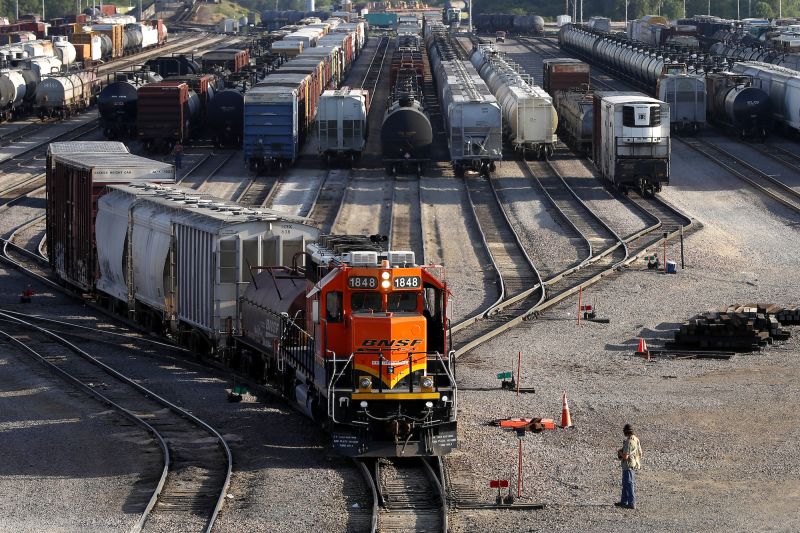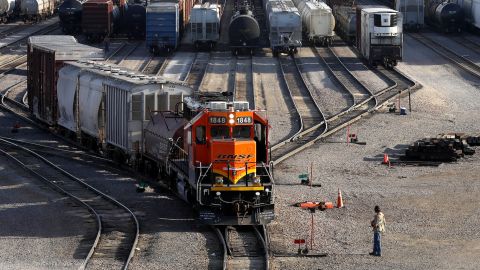
This story is part of CNN Business’ Nightcap newsletter. To get it in your inbox, sign up for free, here.
New York
CNN Business
—
This Friday, tens of thousands of railroad workers are poised to go on strike, potentially bringing a nearly a third of all US freight to a grinding halt. It would be the first national rail strike in 30 years.
As the clock ticks, the threat of the work stoppage is already having an impact. Amtrak preemptively suspended service on some of its long range routes. And railroads have already stopped accepting shipments of hazardous and other security-sensitive materials, citing concerns about the strike.
Here’s the deal: Freight railroads have been around since the 19th century, but you can’t run a 21st century economy without them, my colleague Chris Isidore writes.
And right now, businesses are anxious as the unions representing more than 60,000 workers plan to walk off the job at the end of the week if they can’t secure certain quality-of-life provisions in their contracts. That could mean more empty shelves, temporary factory closures, and — of course — higher prices on consumer goods. It’s also a political chess game for the Biden administration and Democrats, whose midterm election chances had just begun to improve.
Why are workers angry?
This isn’t your usual union pay dispute. In fact, freight railroads have thrived during the pandemic, raking in record profits.
Instead, unions are battling over the rules around scheduling, which forces engineers and conductors to be “on call” seven days a week. And in that line of work, being ready to go means being ready to literally catch a train, not just log in to send some emails from the beach.
They’re fed up with being deprived of personal time, which contributes to a high quit rate, leaving crews woefully understaffed. Employment at the nation’s major railroads is down by more than 30,000, or about 20% of the workforce, since the last contract was reached in 2017.

Leaders say their members are at a breaking point.
“Our members are being terminated for getting sick or for attending routine medical visits as we crawl our way out of worldwide pandemic,” union leaders wrote over the weekend. They said the attendance policies “are destroying the lives of our members, who are the backbone of the railroad industry.”
Key background:
- President Biden prevented a strike two months ago by imposing a 60-day cooling-off period during which a panel he appointed looked at the disputes and offered recommendations.
- Only a handful of the 12 unions have agreed to the panel’s recommendations, which include a 24% pay increase over the next five years and cash bonuses.
- That cooling-off period is due to expire at after at 12:01 am ET Friday. After that, Biden won’t have the power to prevent a strike.
- At that point only Congress would be able to intervene, either by imposing a deal on the two sides or to extending the current cooling-off period. But that would require the two parties to, like, set aside their squabbling and do some actual good for the public.
- The unions themselves are urging Congress butt out. They say a strike is the only way to reach a deal that can improve what they describe as intolerable working conditions.
Even businesses that would be affected by the strike aren’t too keen on Washington settling this fight.
“Quite frankly, it’s not a good sign if it ultimately goes to Congress,” one business official told Chris. “You don’t know what you’re going to get. You could have members that could hold up legislation to demand one thing or the other…Once Congress gets involved, it’s a mess.”
(That’s some tattoo-on-your-arm-worthy, capital-T Truth.)
The political issue
If you were anywhere in the mid-Atlantic and heard a guttural cry ring out from the direction of DC this weekend, that might have been the collective rage-screams of frustrated White House staffers who were just about to be able to take a day off after pushing through the Inflation Reduction Act and federal student loan relief.
No matter how this ends, it’s a tough political calculus for Biden and the Democrats just weeks before the midterm elections.
Biden’s a union guy. That’s kinda central to his whole born-in-Scranton-PA-blue-collar-working-man charm. But he’s also, reasonably, wary of letting a strike take place that could send prices up on key consumer goods just as gas prices are finally coming down and Americans’ attitudes about the economy are improving (more on that later).
The White House told CNN it takes “no position on what the elements of an agreement should be,” but stands ready to support the railroads and the unions as they work toward a deal.
“We are confident the parties will make every effort to negotiate in good faith toward a mutually acceptable solution, and we urge both sides to do so promptly.”
The clock is ticking.
Rail operators are urging the unions to agree to the terms recommended by the presidential panel, warning that a work stoppage would cost the US economy $2 billion a day. It did not specifically call for congressional action, encouraging the parties to settle the dispute through negotiations, although its statement said, “ultimately, Congress has the power to intercede and avert a shutdown.”
RELATED: About 15,000 nurses in Minnesota went on strike Monday, fighting for better staffing and better care for their patients.
It hasn’t exactly been a bonanza year for Wall Street, unless your portfolio is heavily weighted toward fossil fuels. But the US dollar is an exception. The greenback is trading near its highest level in 20 years, with the US Dollar Index soaring nearly 13% since January.
The upshot: It’s a great time to be an American tourist, but a less-great time to be an American multinational, as the strong dollar reduces the value of sales and earnings from their overseas operations.
Once upon a time, the Bureau of Labor Statistics would release its monthly consumer price index reading with little fanfare, and there’s a good chance you never read a single headline about it. These days, though, it’s must-see TV, a breaking news banner, an alert on your phone, one million tweets from armchair economists and actual economists parsing every line of the release.
Why? Because the so-called CPI reading has offered us a snapshot of the economic misery Americans are facing every day as prices surge at their fastest pace in 40 years. It’s the hard data telling us we were correct to shake our fist in the air and curse at the checkout line this weekend over the price of Brussels sprouts.
Here’s the (potential) good news: After more than a year of soaring prices, we may have finally peaked.
Economists expect Tuesday’s CPI reading to show that prices in August were up 8.1% from a year earlier — that’s still historically high, but it would mark a slowdown from the June high water mark of 9.1%.
On Monday, we got another insight into the inflation puzzle that bolsters the June peak theory: According to monthly survey data Federal Reserve Bank of New York, Americans now expect prices to fall sharply, with the median expectation for inflation over the next three years falling to 2.8% from 3.2%.
That may seem like no big deal, but that’s an important metric for policy makers weighing the psychological impact of inflation. The central bank has to not only raise rates to slow spending on a real, economic level but also has to show the public that it is doing something to make people believe prices will stabilize.
BOTTOM LINE
Tomorrow’s CPI report is one of the last big data releases Fed policy makers will have in hand before next week’s policy meeting.
Chairman Jerome Powell has made it clear the central bank will raise rates until it wrangles inflation back down to its 2% target – even if that means higher unemployment or wage stagnation. Traders are predicting yet another hike of three-quarters of a percentage point, or 75 basis points — the third since June.
But, as my colleague Paul R. La Monica explains, the odds of another huge rate hike could edge lower if inflation data suggest prices are stabilizing.
Enjoying Nightcap? Sign up and you’ll get all of this, plus some other funny stuff we liked on the internet, in your inbox every night. (OK, most nights — we believe in a four-day work week around here.)
